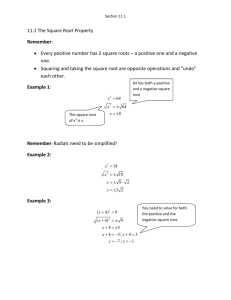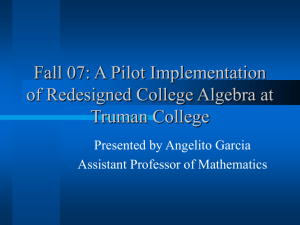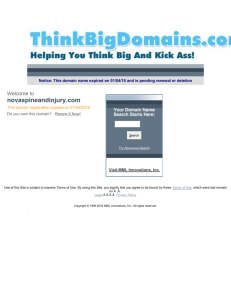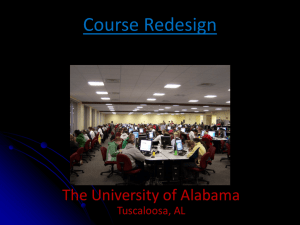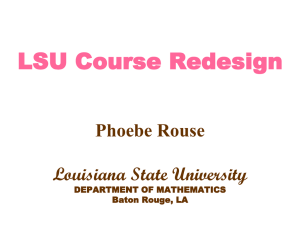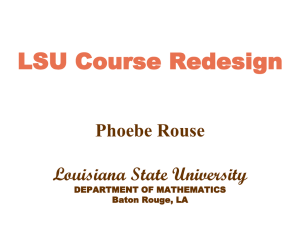Phoebe Rouse
advertisement
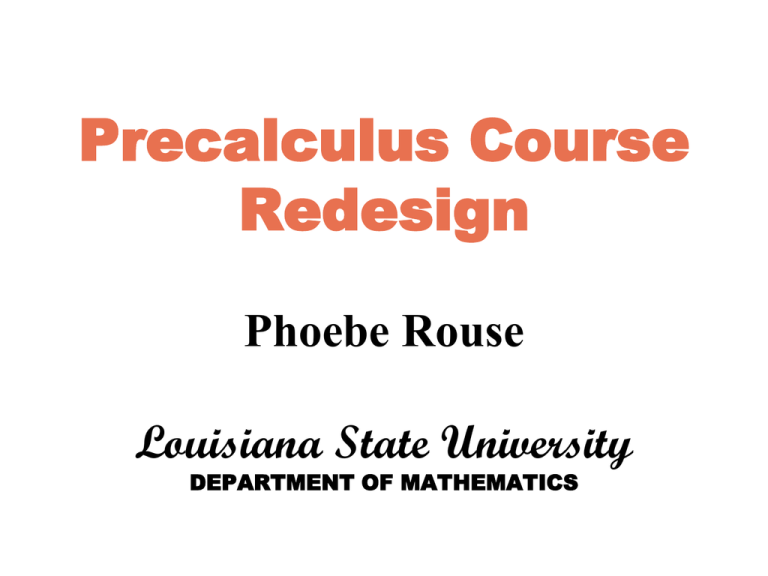
Precalculus Course Redesign Phoebe Rouse Louisiana State University DEPARTMENT OF MATHEMATICS Goals and Results of LSU Precalculus Redesign Fall 2003-Spring 2009 • To reduce personnel costs (savings of 35%) • To incorporate technology to grade student homework (MyMathLab) • To provide consistent content presentation (√) • To continue current success rates (improved) Redesign Timeline at LSU • Spring 2004 - Planning • Fall 2004 - Pilot MyMathLab software, join R2R program • Spring 2005 – Pilot of College Algebra redesign • Fall 2005 - Partial implementation of College Algebra redesign; opened Pleasant Hall 1st floor lab • Spring 2006 – Full implementation of College Algebra redesign; pilot of Precalculus (course) redesign • Fall 2006 - Full implementation of Precalculus (course) redesign; opened Pleasant Hall basement lab; pilot high school redesign program for College Algebra • Spring 2007 - Full implementation of Trigonometry Redesign; pilot high school redesign program for Trigonometry • Fall 2007 - All sections of College Algebra, Trigonometry, and Precalculus (course) redesigned; opened Pleasant Hall basement side room; continue high school redesign program for College Algebra • Spring 2008 – All sections of College Algebra, Trigonometry, and Precalculus (course) redesign; expand high school redesign program for College Algebra and Trigonometry Redesigned Courses College Algebra (3 cr. hrs.) • 2200 students per year • 1 hour per week in class of 40 students • minimum of 3 flexible-time hours per week in lab Trigonometry (3 cr. hrs.) • 1600 students per year • 1 hour per week in class of 40 students • minimum of 3 flexible-time hours per week in lab Precalculus (5 cr. hrs.) • 400 students per year • 2 hours per week in class of 40 students • minimum of 5 flexible-time hours per week in lab Pleasant Hall Math Lab Fall 2005 PH Basement Math Lab Fall 2006 PH Basement Side Room Fall 2007 Lab Features • 275-seat learning lab open 60 hours each week • Capacity of 15 students per 1 computer in learning lab • Test in university testing center • Staggered due dates for all assignments • Staggered attendance week for students • Ratio of 1Tutor/Teachers for each 20 students • AccuTrack student tracking software Pedagogical Keys to Math Redesign Using Technology • Active Learning Experience • Personalized, Individualized Instruction • Immediate Feedback • Repetition to Mastery Final Grade Distribution 10% Participation (5 % class and 5 % lab) 10% Homework (drop lowest 2) 10% Quizzes (drop the lowest 2) 45% Tests (3 - 5 total) 25% Final (replaces lowest test score if higher) College Algebra Fall Results Exam Median # of Students enrolled ABC Rate Fall 2001 Traditional Sections 73% 3115 66% Fall 2002 Traditional Sections 70% 3188 64% Fall 2003 Traditional Sections 72% 3211 68% Fall 2004 LL Sections with MML 80% 742 66% Fall 2004 Traditional Sections 76% 2605 72% Fall 2005 LL Sections with MML 76% 841 66% Fall 2005 Traditional Sections 64% 743 49% Fall 2005 R2R Sections with MML 73% 922 48% Fall 2006 R2R Sections with MML 78% 1724 75% Fall 2007 R2R Sections with MML* 64% 1739 67% Fall 2008 R2R Sections with MML 65% 1772 68% *Course rigor increased. Trig Fall Results Exam Median # of Students enrolled ABC Rate Fall 2001 Traditional Sections 71% 1277 59% Fall 2002 Traditional Sections * 1150 56% Fall 2003 Traditional Sections * 1015 62% 76% 892 61% Fall 2005 XLg Lecture w/ MML * 1350 55% Fall 2006 XLg Lecture w/ MML 72% 1234 63% Fall 2007 R2R Sections with MML 72% 1168 64% Fall 2008 R2R Sections with MML 69% 1231 69% Fall 2004 XLg Lecture w/ MapleTA *No exam median recorded. College Algebra, Trig, Precalculus Fall Participation Grades Class and Lab Participation % A B C D F 70-100% 62% 10% 10% 18% 0-69% W College Algebra Spring Results Exam Median # of Students enrolled ABC Rate Spring 2001 Traditional Sections 68% 1223 50% Spring 2002 Traditional Sections 69% 1191 54% Spring 2003 Traditional Sections 68% 1066 53% Spring 2004 Traditional Sections 68% 1025 64% Spring 2005 Traditional Sections 71% 610 66% Spring 2005 R2R Pilot with MML 61% 196 47% Spring 2006 R2R Sections with MML 67% 567 59% Spring 2007 R2R Sections with MML 71% 384 55% Spring 2008 R2R Sections with MML 61% 418 53% Trig Spring Results Exam Median # of Students enrolled ABC Rate Spring 2001 Traditional Sections 69% 1304 65% Spring 2002 Traditional Sections * 1451 63% Spring 2003 Traditional Sections 64% 1490 63% Spring 2004 Traditional Sections * 1477 69% Spring 2005 XLg Lecture w/ MapleTA * 1252 69% Spring 2006 XLg Lecture w/ MML * 1030 57% Spring 2007 R2R Sections with MML 60% 967 62% Spring 2008 R2R Sections with MML 67% 791 60% *No exam median recorded. College Algebra, Trig, and PC Spring Participation Grades Class and Lab Participation % A B C D F 70-100% 50% 19% 0-69% 7% 24% W Redesign Personnel Program Management • Overall program administrator • Course coordinators for each course • Tutor supervisor • Time clock manager Teaching • Instructors • Upper level math graduate students Lab Tutoring • Instructors • Upper level math graduate students • First-year math graduate students • Ugrad math majors Tech support • Ugrad students from LSU ITS Assignment Settings Homework • Unlimited attempts prior to due date • Help, Examples, Videos, Textbook, and Tutors available • Practice Homework for each section without due dates Quizzes • Ten attempts for each quiz, 75 minute time limit • Restricted re-access • Keep best score • Not proctored or password protected • Tutorials available on review Tests • One attempt, 90 minute time limit • Non-restricted re-access • Proctored and password protected Tutor and Teacher Training 1. Ugrad Tutor Training Program a. Hiring and screening b. Pre-semester workshop 2. First-Year-TA Tutor Training Program a. Pre-semester workshop b. Fall semester Comm Math course c. Spring semester Comm Math course 3. First-Time-Teaching-Redesign Teacher Workshop (R2R Manual) 4. Pre-semester Meeting for All Teaching Elements of a Sustained Redesign • Detailed course syllabus and individual daily schedules • Online assessments and carefully chosen assignment settings • Settings for individual students • Process for importing into and exporting from the gradebook • Precise password management • Allowance for open homework • Rotating lab and efficient time clock management • Well-trained teachers and tutors and constant tutor supervising • Attention to lessons learned Do’s and Don’ts • Do stagger student assignment deadlines to avoid an overloaded lab • Do set up homework and quizzes to be due before the new material is taught. • Do establish credit hour equivalencies prior to assigning teacher’s schedules. • Do increase administrator/coordinator release time to run program. • Do designate a person to manage data, a person to prepare the lab schedule for tutors and train them, and a person to become expert at using the time clock. • Do prepare for the unexpected. • Don’t give up! “Must Haves” for Redesign 1. The support of both the department administration and the upper administration 2. A strong-willed, thick-skinned program director 3. A core group of instructors and professors dedicated to working hard to make the redesign succeed 4. Space and computers for a learning lab 5. A willingness on the part of everyone involved to be flexible and CHANGE 6. A purpose and an overall plan for redesign Contact Info Phoebe Rouse LSU prouse@lsu.edu NCAT Redesign Scholar MyMathLab Faculty Advocate
